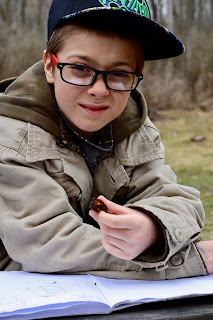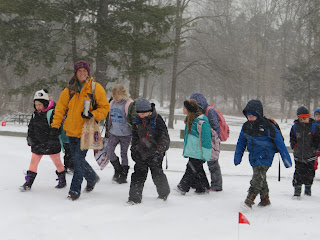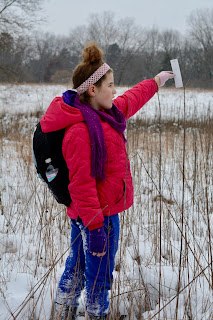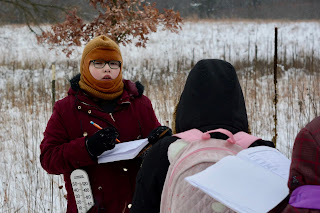These kids were agog over even the tiniest of treasures found in the woods,
energized by their observations,
adorable as they showed their discoveries,
and they seriously never. stopped. moving (or talking).
Over the course of the morning, a few passersby shook their heads and chuckled, likely picking up on the goofiness of this crew. And that assessment wouldn't be untrue. But what's also true is that those kids were completely engaged in their learning. They were chattering away about the things they were seeing and hearing. They were on the hunt for puffballs. They were trying out new vocabulary words like "moraine". They'd learn one thing at one stop and try to apply it to the next stop. They'd overhear a piece of information and share it in discussion as soon as they could. In the truest sense of the word, these kids were lit!
This group had the good fortune of having Kelli Fortino and Mindy Dipple as their teachers this year. Kelli is an actual super-teacher. In the short amount of time I spent with her group, they gave her ample opportunity to show epic patience, unflappable optimism, genuine curiosity, focus, compassion, grit, and all other qualities we associate with superheroes. When I told Kelli she deserved a trophy, she laughed and said, "They're exhausting. I love them."
You can tell a great teacher pretty quickly, and the great thing about the reWired teachers is that they're not only passionate about the environment, stewardship, and nature, but they're also veteran teachers who really Get It when it comes to kids. I could tell Dave Brigham was pretty great before the Discovery Walk had even begun when he triumphantly held up a piece of litter a child had found, like it was the first gift of Christmas. Along the way, students were to keep an eye out for these little treasures and leave the environment better than they found it. Just like that, Dave gave students a sense of purpose that was bigger than their own learning as they embarked along their walk.
Dave had started his day by previewing the area to see what it had to offer that day. In this picture, he's showing them a sycamore tree that had actually grown around a beech tree. In small groups, students got to see this oddity up close.
They also got to hunt for puffballs.
Throughout the walk, Dave got students thinking by asking open-ended questions that he may not already know the answer to, and Kelli modeled the curiosity and engagement she wanted to see in her students. They played back and forth between each other in a totally organic way. Through this kind of interaction, students were not only learning about nature and the environment, they were learning about tools to uncover answers to questions they didn't know the answer to. They were learning about how to continue the quest for knowledge; about curiosity, wonder, and joy. For many of these students, this was their first or earliest experience out in nature; and to think, *this* is what nature has to offer!
This class from Forest View was certainly a special one. Dave's hope is that "by being exposed to nature, students develop a natural appreciation for nature. The calming quality that is generated by being in nature creates an open learning environment that is conducive to retaining knowledge."
Between Kelli's relentless commitment to her students' joy in learning, and this weeklong experience at Annie's BIG Nature Lesson at Fenner and with Dave, I've no doubt these kids will remember the way they felt out here for a lifetime.
“People will forget the things you do, and people will forget the things you say. But people will never forget how you made them feel.”
- Maya Angelou
x


















































